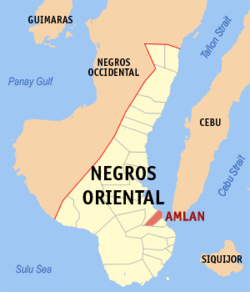Amlan New Ayuquitan | |
|---|---|
| Municipality of Amlan | |
 Church of Amlan | |
 Map of Negros Oriental with Amlan highlighted | |
 Interactive map of Amlan | |
Location within the Philippines | |
| Coordinates: 9°27′52″N123°13′25″E / 9.464367°N 123.223653°E | |
| Country | Philippines |
| Region | Negros Island Region |
| Province | Negros Oriental |
| District | 2nd district |
| Barangays | 8 (see Barangays) |
| Government | |
| • Type | Sangguniang Bayan |
| • Mayor | Manuel Jose C. Sycip (NPC) |
| • Vice Mayor | Allan Marie R. Tan (NPC) |
| • Representative | Ma. Isabel L. Sagarbarria (Lakas) |
| • Municipal Council | Members |
| • Electorate | 18,847 voters (2025) |
| Area | |
• Total | 111.85 km2 (43.19 sq mi) |
| Elevation | 29 m (95 ft) |
| Highest elevation | 334 m (1,096 ft) |
| Lowest elevation | 0 m (0 ft) |
| Population (2024 census) [3] | |
• Total | 26,566 |
| • Density | 237.51/km2 (615.16/sq mi) |
| • Households | 6,158 |
| Economy | |
| • Income class | 4th municipal income class |
| • Poverty incidence | 21.1 |
| • Revenue | ₱ 169.3 million (2022) |
| • Assets | ₱ 322.2 million (2022) |
| • Expenditure | ₱ 131.3 million (2022) |
| • Liabilities | ₱ 80.01 million (2022) |
| Service provider | |
| • Electricity | Negros Oriental 2 Electric Cooperative (NORECO 2) |
| Time zone | UTC+8 (PST) |
| ZIP code | 6203 |
| PSGC | |
| IDD : area code | +63 (0)35 |
| Native languages | Cebuano Tagalog |
| Website | www |
Amlan, officially the Municipality of Amlan (Cebuano : Lungsod sa Amlan; Tagalog : Bayan ng Amlan), is a municipality in the province of Negros Oriental, Philippines. According to the 2024 census, it has a population of 26,566 people. [5]




